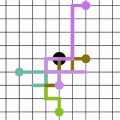Flow and multicomponent reactive transport in saturated/unsaturated porous media are modeled by ensembles of computational particles moving on regular lattices according to specific random walk rules. The occupation number of the lattice sites is updated with a global random walk (GRW) procedure which simulates the evolution of the ensemble with computational costs comparable to those for a single random walk simulation in sequential procedures. To cope with the nonlinearity and the degeneracy of the Richards equation the GRW flow solver uses linearization techniques similar to the $L$-scheme developed in finite element/volume approaches. Numerical schemes for reactive transport, coupled with the flow solver via numerical solutions for saturation and water flux, are implemented in splitting procedures. Diffusion-advection steps are solved by GRW algorithms using either biased or unbiased random walk probabilities. Since the number of particles in GRW simulations can be as large as the number of molecules involved in chemical reactions, one avoids the cumbersome problem of rescaling particle densities to approximate concentrations. Reaction steps are therefore formulated in terms of concentrations, as in deterministic approaches. The numerical convergence of the new schemes is demonstrated by comparisons with manufactured analytical solutions. Coupled flow and reactive transport problems of contaminant biodegradation described by the Monod model are further solved and the influence of flow nonlinearity/degeneracy and of the spatial heterogeneity of the medium is investigated numerically.
翻译:在饱和/不饱和、不饱和的多孔多介质中,流动和多构体活性迁移的模型是,根据具体的随机行走规则,在固定的顶部行走规则下,用计算粒子堆积在固定的顶部,用全球随机行走(GRW)程序进行更新,以全球随机行走(GRW)程序来模拟混合体的演进,计算成本与单随机行走模拟相仿。为了应对理查斯等式的不线性和变异性,GRW流求解器使用线性技术,类似于在有限元素/量方法中开发的美元-制成法。反应式运输的数值计划,加上通过饱和和和和和和水通性的数字解决方案,在分裂程序中执行流动,通过GRWS演算法解决共变异性步骤。由于GRWM模拟中粒子数量与化学反应中的分子数量一样多,因此避免了调整粒子密度到近似浓度的麻烦问题。因此,通过分析性流的递解的递化分析方法,以递化递解的递解性递化方法来确定其递化的递化的递化的递化的递化的递化方法,其递化的递化的递化的递化的递化的递化方法是确定了递化的递制成。





